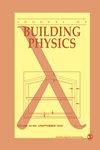A comparison of hygrothermal simulation results derived from four simulation tools
IF 1.4
4区 工程技术
Q3 CONSTRUCTION & BUILDING TECHNOLOGY
引用次数: 11
Abstract
The objective of this work was to compare the hygrothermal responses and the moisture performance of four wood-frame walls as predicted by four hygrothermal (HAM) simulation tools, namely: DELPHIN, WUFI, hygIRC and COMSOL. The four wall systems differ only in their cladding type; these were fibreboard, vinyl, stucco and brick. Three Canadian cities having different climates were selected for simulations: Ottawa, Ontario; Vancouver, British Columbia and Calgary, Alberta. In each city, simulations were run for 2 years. Temperature and relative humidity of the outer layer of OSB sheathing were compared amongst the four simulation tools. The mould growth index on the outer layer of the OSB sheathing was used to compare the moisture performance predicted by the respective hygrothermal simulation tools. Temperature profiles of the outer layer of the OSB sheathing were all in good agreement for the four HAM tools in the three locations. For relative humidity, the highest discrepancies amongst the four tools were found with stucco cladding where differences as high as 20% could be found from time to time. Mould growth indices predicted by the four HAM tools were similar in some cases but different in other cases. The discrepancies amongst the different HAM tools were likely related to: the material property processing, how the quantity of wind-driven rain absorbed at the cladding surface is computed and some implementation details. Despite these discrepancies, The tools generally yielded consistent results and could be used for comparing the impacts of different designs on the risk of premature deterioration, as well as for evaluating the relative effects of climate change on a given wall assembly design.四种模拟工具的热液模拟结果比较
这项工作的目的是比较四个木结构墙的湿热响应和湿性能,这四个湿热(HAM)模拟工具分别是:DELPHIN、WUFI、hygIRC和COMSOL。四种墙体体系的不同之处在于其包层类型;这些是纤维板、乙烯基、灰泥和砖。三个加拿大城市有不同的气候选择模拟:渥太华,安大略省;不列颠哥伦比亚省的温哥华和阿尔伯塔省的卡尔加里。在每个城市,模拟运行了2年。比较了四种模拟工具对OSB护套外层温度和相对湿度的影响。利用OSB护套外层的霉菌生长指数来比较各自湿热模拟工具预测的湿性能。OSB护套外层的温度分布在三个位置的四个HAM工具都很好地一致。对于相对湿度,四种工具之间的差异最大的是灰泥包层,有时差异高达20%。四种HAM工具预测的霉菌生长指数在某些情况下相似,但在其他情况下不同。不同HAM工具之间的差异可能与:材料属性处理,如何计算包层表面吸收的风驱动雨的数量以及一些实现细节有关。尽管存在这些差异,这些工具通常产生一致的结果,可用于比较不同设计对过早变质风险的影响,以及评估气候变化对给定壁组件设计的相对影响。
本文章由计算机程序翻译,如有差异,请以英文原文为准。
求助全文
约1分钟内获得全文
求助全文
来源期刊

Journal of Building Physics
工程技术-结构与建筑技术
CiteScore
5.10
自引率
15.00%
发文量
10
审稿时长
5.3 months
期刊介绍:
Journal of Building Physics (J. Bldg. Phys) is an international, peer-reviewed journal that publishes a high quality research and state of the art “integrated” papers to promote scientifically thorough advancement of all the areas of non-structural performance of a building and particularly in heat, air, moisture transfer.
 求助内容:
求助内容: 应助结果提醒方式:
应助结果提醒方式:


